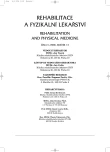Cervical Spine in Relationship to Etiology Disorders of Cervical Region
KRČNÍ PÁTEŘ VE VZTAHU K ETIOLOGII PORUCH KRČNÍHO REGIONU
Článek pojednává o opomíjené biomechanice krční páteře, včetně anatomických vztahů v tomto regionu. Cílem práce je poukázat na vztah mezi stavem svalového napětí svalů krčního regionu a tvarem krční páteře, a to u jedinců s klinickou symptomatologií vertebrogenních algických syndromů krční páteře. Jako metody pro tento probíhající výzkum jsou voleny: palpace, zobrazovací metody typu NMR a kinematická analýza pohybu pomocí videosekvence. Výsledek práce je určen především klinikům pro praxi v oblasti zátěže a poruch funkce krčního regionu a vědcům bádajícím v oblasti vlastností osového orgánu lidského organismu.
Klíčová slova:
krční páteř, svalové napětí, tvar a postavení krční páteře
Authors:
J. Čemusová
Authors‘ workplace:
Katedra fyzioterapie FTVS UK, Praha
vedoucí katedry doc. PaedDr. D. Pavlů, CSc.
Published in:
Rehabil. fyz. Lék., 13, 2006, No. 1, pp. 38-41.
Category:
Original Papers
Overview
This article deal about biomechanics of a cervical spine including anatomy of this region. Muscle tone is the main factor for this work as a factor which influate shape and position of cervical spine especially with the patient with clinical symptomatology of vertebrogenic algic syndroms of cervical spine. There will be used methods as a palpation, visual methods as a NMR and kinematography. Next goal is to find adequate marks in relationship between muscle tone and shape of cervical spine which will be good output for clinical practice.
Key words:
cervical spine, muscle tone, biomechanics of cervical spine
Labels
Physiotherapist, university degree Rehabilitation Sports medicineArticle was published in
Rehabilitation & Physical Medicine

2006 Issue 1
- Hope Awakens with Early Diagnosis of Parkinson's Disease Based on Skin Odor
- Deep stimulation of the globus pallidus improved clinical symptoms in a patient with refractory parkinsonism and genetic mutation
Most read in this issue
- Possibilities of Therapeutic Climbing in Physiotherapy
- Cervical Spine in Relationship to Etiology Disorders of Cervical Region
- Clinical Significance of Trigger Point in Acromial Part of Deltoid Muscle
- Significance of Soft Parts in the Origin of Sacroiliac Dysfunctions in Posttraumatic Conditions of Lower Extremities
